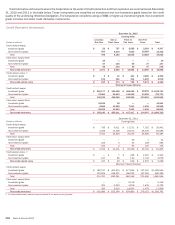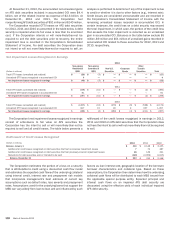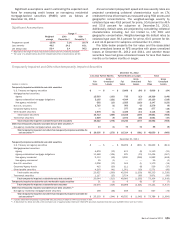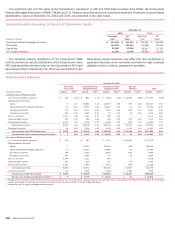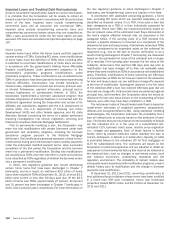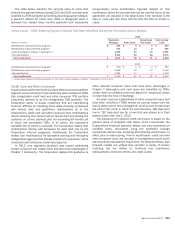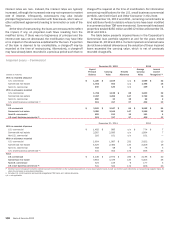Bank of America 2012 Annual Report Download - page 188
Download and view the complete annual report
Please find page 188 of the 2012 Bank of America annual report below. You can navigate through the pages in the report by either clicking on the pages listed below, or by using the keyword search tool below to find specific information within the annual report.186 Bank of America 2012
The Corporation mitigates a portion of its credit risk on the
residential mortgage portfolio through the use of synthetic
securitization vehicles. These vehicles issue long-term notes to
investors, the proceeds of which are held as cash collateral. The
Corporation pays a premium to the vehicles to purchase mezzanine
loss protection on a portfolio of residential mortgage loans owned
by the Corporation. Cash held in the vehicles is used to reimburse
the Corporation in the event that losses on the mortgage portfolio
exceed 10 basis points (bps) of the original pool balance, up to
the remaining amount of purchased loss protection of $500 million
and $783 million at December 31, 2012 and 2011. The vehicles
from which the Corporation purchases credit protection are VIEs.
The Corporation does not have a variable interest in these vehicles,
and accordingly, these vehicles are not consolidated by the
Corporation. Amounts due from the vehicles are recorded in other
income (loss) when the Corporation recognizes a reimbursable
loss, as described above. Amounts are collected when
reimbursable losses are realized through the sale of the underlying
collateral. At December 31, 2012 and 2011, the Corporation had
a receivable of $305 million and $359 million from these vehicles
for reimbursement of losses, and principal of $17.6 billion and
$23.9 billion of residential mortgage loans was referenced under
these agreements. The Corporation records an allowance for credit
losses on these loans without regard to the existence of the
purchased loss protection as the protection does not represent a
guarantee of individual loans.
In addition, the Corporation has entered into long-term credit
protection agreements with FNMA and FHLMC on loans totaling
$24.3 billion and $24.4 billion at December 31, 2012 and 2011,
providing full protection on residential mortgage loans that become
severely delinquent. All of these loans are individually insured and
therefore the Corporation does not record an allowance for credit
losses related to these loans. For additional information, see Note
8 – Representations and Warranties Obligations and Corporate
Guarantees.
Nonperforming Loans and Leases
In 2012, the bank regulatory agencies jointly issued interagency
supervisory guidance on nonaccrual status for junior-lien
consumer real estate loans. In accordance with this regulatory
interagency guidance, the Corporation classifies junior-lien home
equity loans as nonperforming when the first-lien loan becomes
90 days past due even if the junior-lien loan is performing, and as
a result, an incremental $1.5 billion was included in nonperforming
loans at December 31, 2012. The regulatory interagency guidance
had no impact on the Corporation’s allowance for loan and lease
losses or provision for credit losses as the delinquency status of
the underlying first-lien loans was already considered in the
Corporation’s reserving process.
In 2012, new regulatory guidance was issued addressing
certain consumer real estate loans that have been discharged in
Chapter 7 bankruptcy. In accordance with this new guidance, the
Corporation classifies consumer real estate and other secured
consumer loans that have been discharged in Chapter 7
bankruptcy and not reaffirmed by the borrower as TDRs,
irrespective of payment history or delinquency status, even if the
repayment terms for the loan have not been otherwise modified.
The Corporation continues to have a lien on the underlying
collateral. Previously, such loans were classified as TDRs only if
there had been a change in contractual payment terms that
represented a concession to the borrower. The net impact upon
implementation to the consumer loan portfolio of adopting this
new regulatory guidance was $1.2 billion in net new nonperforming
loans, and $1.1 billion of such loans were included in
nonperforming loans at December 31, 2012. Of the $1.1 billion,
$1.0 billion, or 92 percent, were current on their contractual
payments. Of these contractually current nonperforming loans,
more than 70 percent were discharged in Chapter 7 bankruptcy
more than 12 months ago, and more than 40 percent were
discharged 24 months or more ago. As subsequent cash payments
are received, the interest component of the payments is generally
recorded as interest income on a cash basis and the principal
component is generally recorded as a reduction in the carrying
value of the loan.


